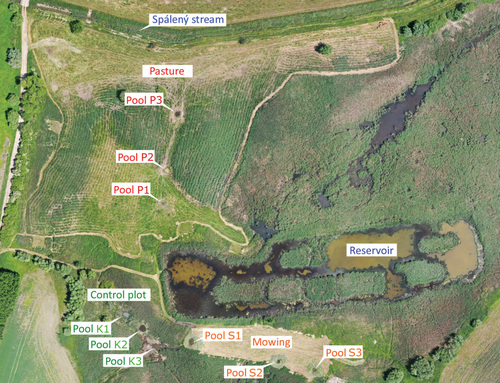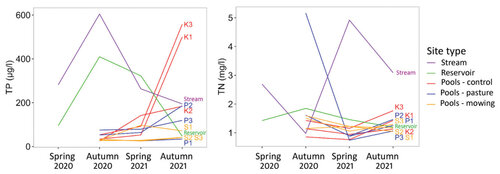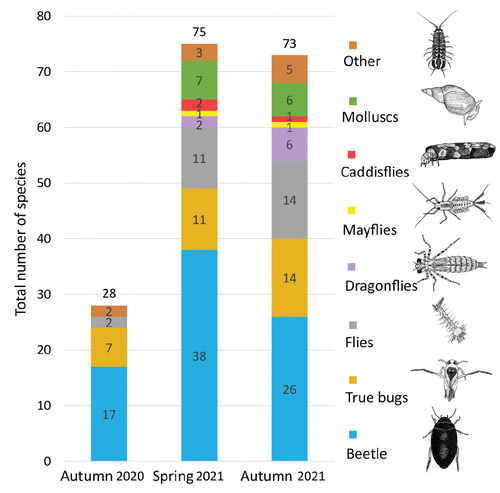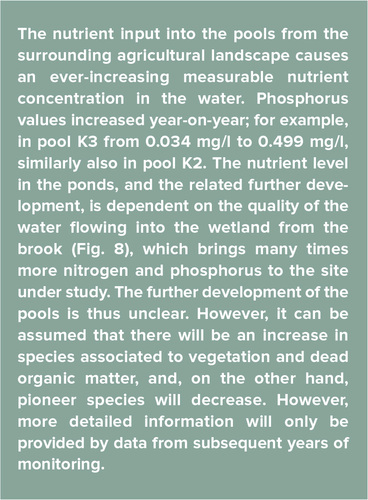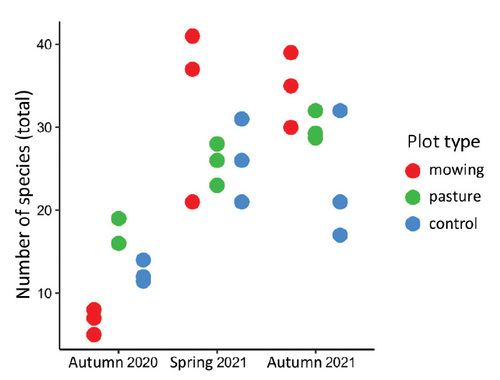Nature Conservation 2023 — 5. 6. 2023 — Research, Surveys and Data Management — Print article in pdf
Restoration of a meadow wetland and its effect on aquatic invertebrates
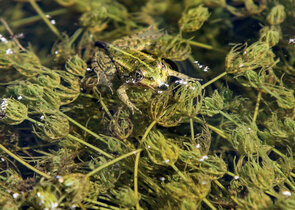
Lowland wetland meadows are among the most endangered habitats in the Czech Republic. The main drivers of their decline and loss include particularly decline in traditional management measures, targeted draining, consequent overgrowing by natural self-seeding as well as spreading aggressive plant species the latter excluding wild plant and animal species there. Thus, suitable meadow wetland management should aim namely at maintaining an open character of the above habitat effectively provided by grazing and mowing.. Although it may not be apparent at first glance, these measures can also significantly affect small water bodies in the immediate vicinity of the managed area. The article presents the project entitled Management measures and assessment of their impact on meadow wetland biodiversity and it introduces the pilot results of water body hydrobiological monitoring in a meadow wetland near the village of Krumvíř (South Moravia).
Figure 1: Aerial photograph of the project site taken using a drone, registration number OK-X071A. © Lubomír Tichý.
Characteristics and development of the project site
The meadow wetland project site in the Spálený potok Brook Valley floodplain, located in the village of Krumvíř cadastral area (South Moravian Region, District of Břeclav), is a typical example of disturbed wetland habitats highly threatened by degradation. The wetland is characterized by numerous more or less waterlogged areas located on both banks of the Spálený potok/Burnt Brook. In the 20th century it was used as a communal pasture where cattle and poultry grazed; hay was also harvested on many plots. These management methods were beneficial for many rare wetland wild plant and animal species, including rare halophilic species recorded there in the 19th and 20th centuries (e.g. FORMÁNEK 1887-1897). However, due to the reduction of small-scale farming in the South Moravian countryside, together with landscape drainage, the use of waterlogged meadows soon began to decline. The Spálený potok/Burnt Brook bed was also modified, deepened and straightened. A fundamental milestone had been the construction of an agricultural drainage system in the 1970s, which significantly changed the rainfall-runoff conditions in a large part of the Czech Republic. In addition, inappropriate agricultural management has led to the so-called cultural eutrophication associated with the excessive use of fertilizers and the subsequent nutrient runoffs into streams and wetlands, in which the runoffs further increase the trophy of entire wetland ecosystems. Despite the drainage and intensive agricultural management in the surrounding landscape, however, the wetland in the Spálený potok/Burnt Brook Valley floodplain has been preserved, including its periodic flooding.
Figure 2: Development of one of the pools built on the pasture. The upper row presents the state of the pools (from left) in the period (i) September 2020 shortly after excavation; (ii) the October 2020 floods; (iii) February 2021; and (iv) March 2021. The lower row in the period (v) April 2021; (vi) May 2021; (vii) July 2021; and (viii) August 2021. © Marie Kotasová Adámková
The wetland is located on an area of approximately 11 ha along a short section of the brook, which is shallow there and floods the wetland annually with varying periodicity and frequency within the year. As part of municipality restoration efforts, a water reservoir with an area of 0.9 ha was built at the site in 2003; its purpose was to stabilize and expand suitable conditions for the occurrence of wetland wild animal populations. Unfortunately, the project was just a one-off action with a plan to leave the site to natural development and to exclude use. Further deve-lopment of the site was therefore quite predictable: landfilling of small terrain depressions, eutrophication of the water reservoir, overgrowth with reeds, and spread of invasive alien plant species. Species diversity of the monitored wild animal groups (namely amphibians, reptiles, and birds) has begun to significantly decline since 2012 (KOTASOVÁ ADÁMKOVÁ, unpublished data). Due to the advanced level of degradation over the entire site and its potential for the occurrence of a large number of rare and endangered species, a total restoration was proposed using the construction of new pools, mosaic mowing, and cattle grazing. These activities, together with thorough monitoring of the overall wetland biodiversity implemented on both experimental and control non-intervention plots, are carried out within the framework of the above-mentioned project supported by the Technology Agency of the Czech Republic (project no. TJ04000145).
Figure 3: Changes in the total phosphorus (TP) and nitrogen (TN) level in water during the spring and autumn seasons of 2020 and 2021. Values from a stream, a reservoir, and nine ponds are presented, which are coded with the letters K (no intervention area), P (pasture), and S (mowing). © Jana Petruželová
Building/creating pools: why and how?
In the undisturbed landscape, pools were naturally formed in the floodplains of lowland brooks and rivers by their spilling into terrain depressions or by the formation of cut-off meanders. However, disruption of the flood regime through stream canalization led to the disappearance of natural floodplain pools. In the Czech Republic´ s landscape, standing/stagnant water is therefore mainly represented by fishponds, while small shallow pools without predation pressure from fish are desperately missing in the current landscape (SYCHRA et al. 2021). The aim of building new pools on the meadow wetland near the village of Krumvíř was the creation of a new, suitable habitat type, thereby supporting local biodiversity.
The parameters of pools and their location were selected with regard to their use as experimental plots for monitoring the progress of colonization and further development of aquatic invertebrate communities, taking into account the specific management of plots in the immediate vicinity of the pools. In total, nine pools were built using light machinery during September 2020: three in the grazed area, three in the mowed area, and three in the control non-intervention plots with reeds (Fig. 1). Each pool had a diameter of five metres and sloping banks with a maximum central depth of up to 100 cm. A relatively deeper excavation was selected with regard to the expected silting of the ponds during numerous floods (Fig. 2).
First results of aquatic invertebrate monitoring
Monitoring the aquatic invertebrate community started in the existing reservoir and the Spálený potok/Burnt Brook in May 2020. It was repeated in September 2020, this time also in the newly built pools. Subsequent sampling took place in May and September 2021, while a similar timing of monitoring was also planned for 2022. Although a relatively short time has passed to evaluate the development of the communities in the pools, the pilot data has already brought some interesting information.
At the start of monitoring, after almost twenty years of existence, the reservoir was heavily overgrown with aquatic plants, especially hornwort (Ceratophyllum sp.). The environment was very homogeneous and the steep banks were overgrown with impenetrable reeds. The water had low transparency, high conductivity, and contained high nutrient level: 1.43 mg/l nitrogen and 0.095 mg/l phosphorus, which fluctuated significantly during subsequent samplings (Fig. 3). The detected concentrations thus correspond to eutrophic to hypertrophic water trophy (ADÁMEK et al. 2010), which is manifested by vegetation overgrowth, subsequent excessive decomposition of organic matter, and higher oxygen consumption. These accompanying eutrophication processes have a negative effect on the aquatic invertebrate community composition.
A total of 129 macroscopic aquatic invertebrate species and 29 zooplankton species were recorded in the water reservoir. All species found are characterized by the ability to tolerate pollution and lack of oxygen. However, the low numbers of individuals in most species indicated that the reservoir is not an optimal habitat for their life due to its homogeneity. In contrast, a few of the most adaptable species occurred in large numbers; for example, the the Small red-eyed damselfly (Erythromma viridulum) adapted to life in the submerged vegetation of densely overgrown water reservoirs (WALDHAUSER & ČERNÝ 2015). The most species-rich order of insects in the reservoir were beetles (45 species); however, two-thirds of them were recorded only in the spring season. Several less-common species specialized in densely overgrown waters were also recorded in the reservoir; for example, the beetle species Cybister lateralmarginalis, the Dainty damselfly (Coenagrion scitulum), and the only spider species permanently inhabiting the aquatic environment, the water spider (Argyroneta aquatic), also known as the Diving bell spider. The zooplankton composition was seasonally very variable, with the dominance of water fleas Chydorus sphaericus and Daphnia curvirostris. These species are also typical for eutrophic habitats with an increased nutrient supply.
Only a week after their building, several species of aquatic insects and zooplankton were found in the pools. These were mainly beetles and true bugs that actively fly and therefore have the ability to quickly colonize new water bodies. We attribute the rare occurrence of common copepod (Cyclopoida and Harpacticoida) species either to their previous presence in the substrate at the excavation site, or to passive transmission by other animals. In the following year, representatives of most invertebrate groups inhabiting standing/stagnant waters appeared in the pools (Fig. 4). Many of them are the so-called pioneer species preferring newly established water bodies.
Figure 4: Total number of macroscopic aquatic invertebrate species found in the newly built pools within three samplings. The numbers in the columns express the number of species in the given invertebrate group (or higher taxa, genera or families, especially with flies). The "Other" group includes crustaceans, leeches, arachnids, and cnidarians. © Jana Petruželová
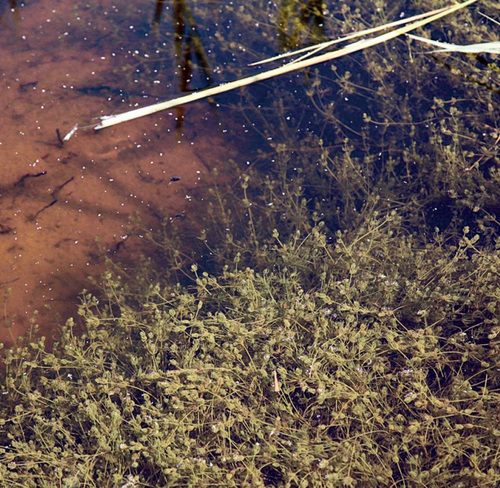
Figure 5: Ponds overgrown with charophyte green algae of the Chara genus. The common Chara vulgaris was recorded, but also the rarer Chara hispida. © Marie Kotasová Adámková.
Among the beetles, eurytopian species (e.g. diving beetles, namely the Supertramp beetle Rhantus suturalis and Hydroglyphus geminus) first had appeared in the ponds, and among the true bugs, these had been typical pioneer species that are good flyers (water boatmans Sigara lateralis and S. nigrolineata). The following year beetles preferring a sandy or muddy substrate overgrown with algae occurred there (crawling water beetles Haliplus fluviatilis and H. ruficollis) and some rarer species from the Red List of the Czech Republic preferring smaller warm water bodies (e.g. crawling water beetles Bidessus nasutus and Laccophilus poecilus; BOUKAL et al. 2007). As the algal vegetation grew (Fig. 5), species of true bugs associated to it appeared, such as pygmy backswimmer Plea minutissima and the Saucer bug (Ilyocoris cimicoides).
Figure 6: Selected species recorded as part of monitoring. © Marie Kotasová Adámková & Jana Petruželová.
The first dragonfly larvae appeared in the ponds only in 2021. Some of the pioneer species of this group, e.g. the Common broad-bodied chaser (Libellula depressa), the Emperor dragonfly (Anax imperator), but also the rarer White-tailed skimmer (Orthetrum albistylum), were not recorded in the reservoir at all, or they occurred very rarely (the Scarlet dragonfly Crocothemis erythraea). At the same time, representatives of other insect orders, mayflies and caddisflies, appeared in the pools, and the number of flies increased. Furthermore, representatives of molluscs and crustaceans of the permanent aquatic fauna were recorded in the pools, e.g. the Water louse Asellus aquaticus and water fleas, which probably colonized the pools during the linking of water bodies by spilling of the stream into the wetland area, or by transfer on vertebrates. In total, 110 aquatic invertebrate species have been found in the pools during monitoring so far, although the average species richness in the individual pools was 50 species. A large part of the species was therefore only found in some pools, which confirms the importance of building a large number of small water bodies in different places on a given site. Selected captured species are presented in Figure 6.
Figure 7: Comparison of number of species in pools at the mowed, grazed, and control project site, recorded during the three sampling events to date. Missing data from one pool on the grazed area is due to the pool drying up in the autumn of 2020. © Jana Petruželová.
Influence of management on pool development
The pilot results show that the implemented management of wetland habitats demonstrably affects the characteristics of pools which are generally considered to be favourable for the occurrence of a number of invertebrate species. Grazing and mowing reduces the growth of reeds on the banks of pools and thereby increases the amount of sunlight falling on the water, which directly supports the growth of algae as well as increases the temperature and accessibility of water from the surrounding area. In the pasture, livestock trampling increases the heterogeneity of pools and the proportion of shallows (Fig. 2), which are essential for a rich diversity in aquatic invertebrates (JIRKŮ & DOSTÁL 2015).
The differences in species richness recorded between the individual trios of ponds shortly after their creation probably only reflect the different course of colonization depending on as yet unknown variables. The pools built on the grazed and control plots in further periods hosted a similar number of species, regardless of the management type (Fig. 7). Only the communities of the two pools located in the no-intervention control plot were significantly poorer in terms of species in the autumn of 2021, which we attribute to the location in the overgrown and often flooded part of the wetland, where decaying organic matter accumulates, causing frequent occurrence of anoxic conditions. In general, newly built pools in a eutrophic environment overgrow quickly without proper management, and are therefore often unattractive to a large part of the biota (including aquatic invertebrates) very quickly after their building.
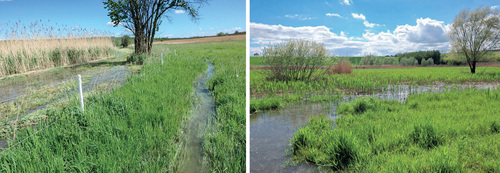
Figure 8: Water from the brook flows into the wetland mainly after higher rainfall, after which the brook leaves its bed in many places (left) and then flows into temporary channels through which it flows directly to the pasture (right). © Marie Kotasová Adámková.
Conclusion: the only certainty is change
Of the total number of 158 aquatic invertebrate species reported from the site so far, 18% were found only in pools. Initial results show that early-stage pools serve as refuges for many species, including species completely new to the wetland. We believe that the combined effect of flooding and ongoing management will result in the continued development of the pools in a varied mosaic of suitable habitats for a large number of species. However, management measures, namely adequate mowing and extensive grazing, will play a fundamental role there. Removing vegetation around pools should lead to a reduction in nutrient concentration, but it has not been known whether these local measures can effectively compensate for the constant nutrient supply from the surroundings. Eutrophication is a problem that goes far beyond the management of a single site, and which can only be significantly mitigated by large-scale measures at a region level. However, new knowledge on impact of properly set wetland habitat management would contribute to elaborating measures to be applied in degraded meadow wetland restoration on a wider scale and thus to important agriculture landscape improvement.
---
Acknowledgement
The project is co-financed from the State Budget through the Technology Agency of the Czech Republic with the ZÉTA Programme. www.tacr.cz Research useful for the society


